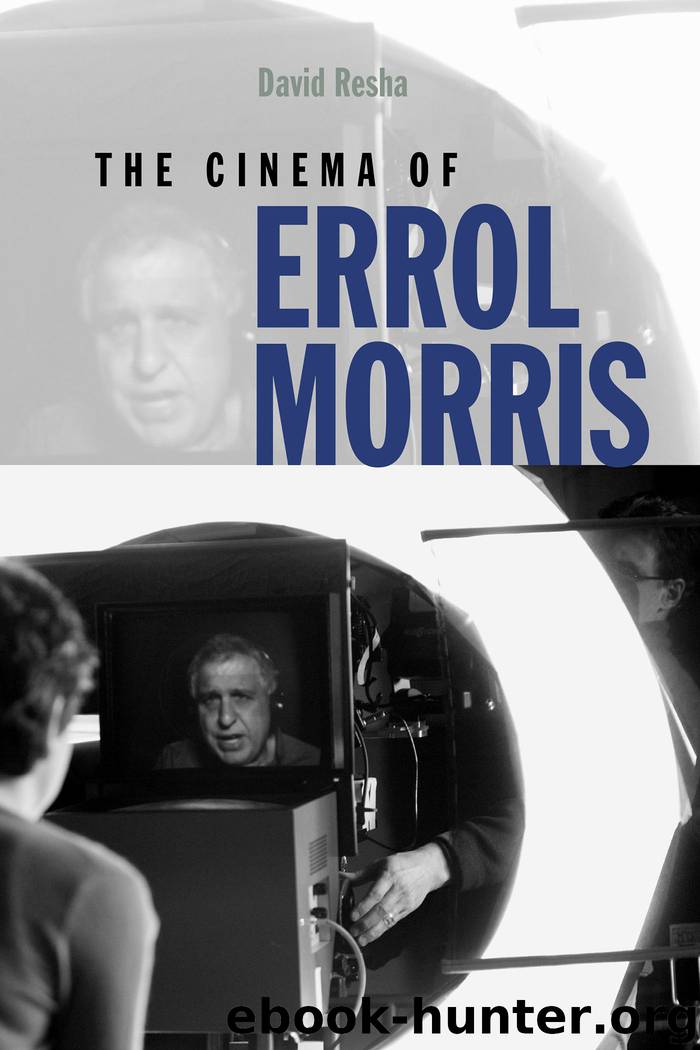The Cinema of Errol Morris by Resha David

Author:Resha, David
Language: eng
Format: epub
Publisher: Wesleyan University Press
Published: 2015-03-11T16:00:00+00:00
▪ Style
Ever since his first film, Morris has wanted to provide the impression that his interview subjects were making eye contact with the audience. Morris’s desire for eye contact is in part a response to what he understands as a larger problem in documentary filmmaking: “Almost all interviews are filmed verité style with a camera, an interviewer and subject. You have a triangle where the camera takes the role of an observer, even voyeur. The camera is the third person observing two people talking. It’s off to the side, and even though I’m looking into your eyes and you’re looking into mine, this eye contact is something that the camera, sitting some feet from us both, doesn’t capture. This means that the audience isn’t really part of the conversation. They are merely observing it.”10 Morris would often place his head close to the camera to achieve the effect of a more immediate connection between interview subject and audience, although the subject’s line of sight was always slightly off-axis.
Morris developed the Interrotron as a solution to this problem. The Interrotron is an interviewing system that his wife facetiously named by combining the words “interview” and “terror.” As noted in the previous chapter, Morris uses a rigged teleprompter system in which the interview subjects speak to a projected image of Morris’s face and Morris speaks to a projected image of their face. This interview system allows Morris to make eye contact with his subjects while his subjects look directly into the lens of the camera. Morris boasts that the Interrotron marks “the difference between faux first person and the true first person…. The Interrotron inaugurates the birth of true first-person cinema.”11
One disadvantage of the Interrotron is that Morris’s interview subjects are looking at his projected image instead of his actual face. This physical disconnect with the interviewer has the potential of negatively affecting the interview subject’s comfort as well as the reliability and depth of the testimony. Morris recognizes this problem: “Seeing myself on screen like that for the first time I remember thinking ‘How could anybody talk looking at this person?’ But thankfully they do…. My production designer, Ted Bafaloukos, said to me, ‘The beauty of this thing is that it allows people to do what they do best: watch television.’ But the people being interviewed aren’t watching regular TV. They’re watching a TV set that really cares and wants to know more.”12
It is difficult to resolve this question about the influence of the Interrotron on the interview testimony, but it has had definite impact on Morris’s visual design. As we observed in the first chapter, Morris’s desire for eye contact influenced the shot scales in his earlier films. Closer framings would highlight the fact that his interview subjects were looking not into the lens but rather at Morris offscreen. This is one reason Gates of Heaven, Vernon, Florida, and A Brief History of Time most frequently use medium shots for the interviews.
The interview framing patterns in Fast, Cheap and Out of Control are significantly different than all of Morris’s previous documentaries.
Download
This site does not store any files on its server. We only index and link to content provided by other sites. Please contact the content providers to delete copyright contents if any and email us, we'll remove relevant links or contents immediately.
| Dance | Individual Directors |
| Magic & Illusion | Reference |
| Theater |
Call Me by Your Name by André Aciman(20371)
Ready Player One by Cline Ernest(14522)
How to Be a Bawse: A Guide to Conquering Life by Lilly Singh(7387)
Wiseguy by Nicholas Pileggi(5669)
The Kite Runner by Khaled Hosseini(5082)
On Writing A Memoir of the Craft by Stephen King(4863)
Audition by Ryu Murakami(4842)
The Crown by Robert Lacey(4722)
Call me by your name by Andre Aciman(4615)
Gerald's Game by Stephen King(4575)
Harry Potter and the Cursed Child: The Journey by Harry Potter Theatrical Productions(4439)
Dialogue by Robert McKee(4321)
The Perils of Being Moderately Famous by Soha Ali Khan(4169)
Dynamic Alignment Through Imagery by Eric Franklin(4116)
Apollo 8 by Jeffrey Kluger(3635)
Seriously... I'm Kidding by Ellen DeGeneres(3576)
The Inner Game of Tennis by W. Timothy Gallwey(3575)
How to be Champion: My Autobiography by Sarah Millican(3554)
Darker by E L James(3475)
